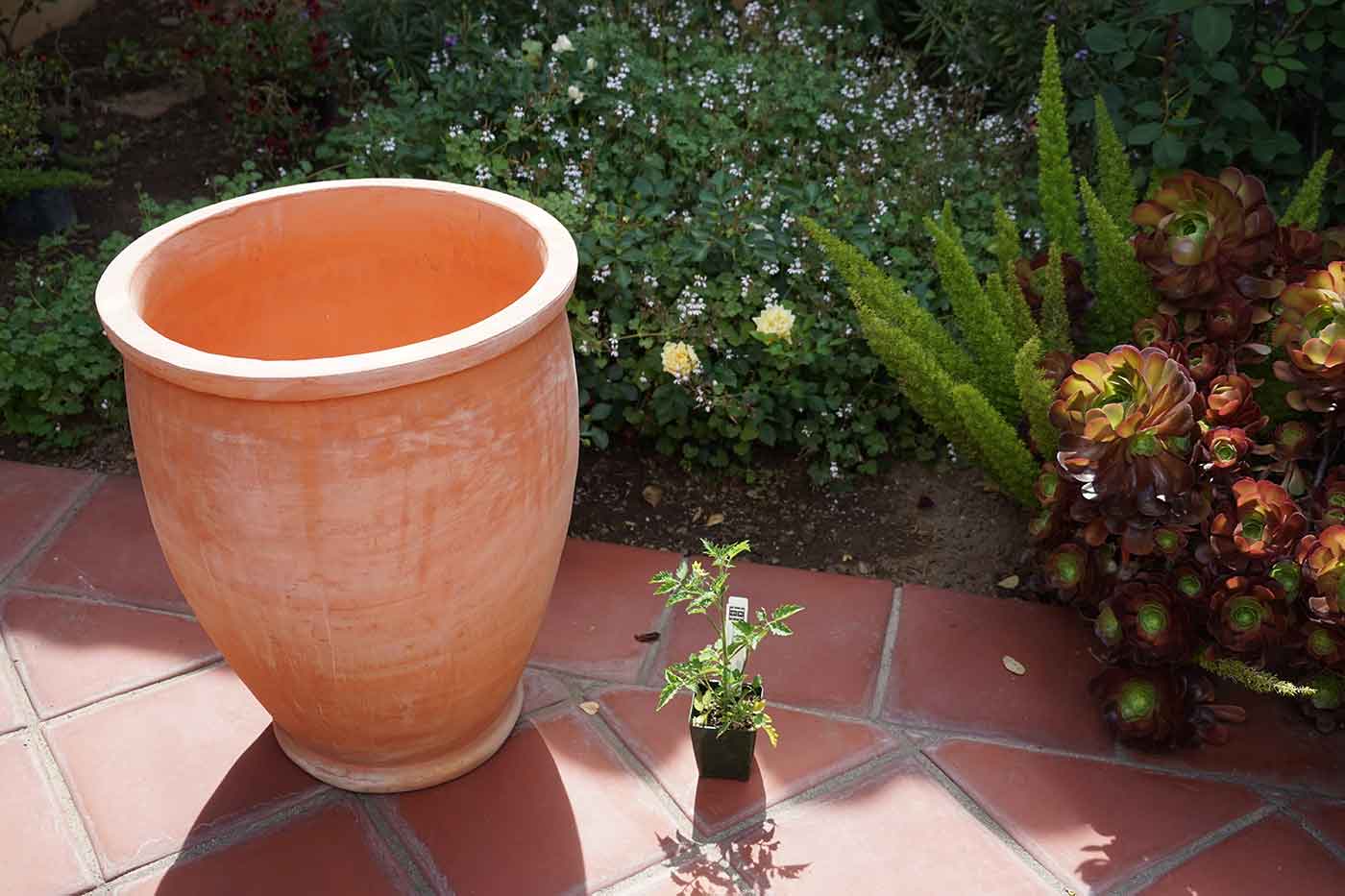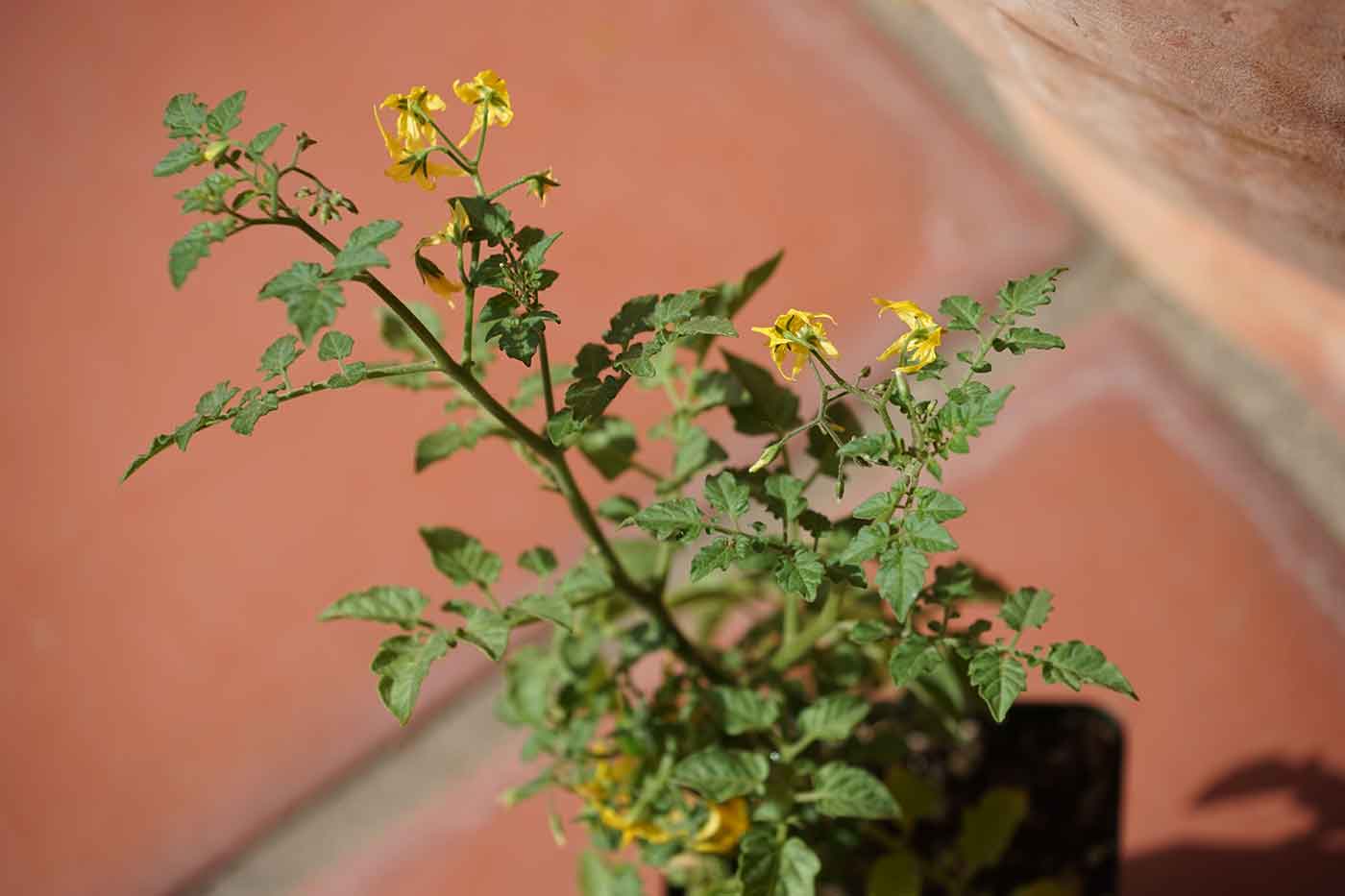
Growing Tomatoes in Pots
Black Pearl, Napa Grape, Maglia Rosa, Hawaiian Currant, Chiapas Wild, Green Zebra. You can tell from their names, tomatoes are the exotic jewels of a garden, painting it with fiery colors and tie-dye patterns. And if you have ever tasted a ripe heirloom, you know like I do that these magic nightshades can distill dirt, sunshine and water into sweet-tart perfection. If you lack the right spot for planting them in a yard, growing tomatoes in pots is an excellent way to make room for a garden on a patio, deck or driveway.
For me, giving up meat has broadened my pallet and made me eat and appreciate other foods, including some of the best fruits and vegetables around. Today I think a tomato fresh off the vine tastes better even than cheese, one of the hardest things to give up, partly because it reminds me of being outdoors in the summertime!
Enjoying one of these fruits picked in your yard, or apartment balcony, does require some planning, a few supplies, and plenty of water. For tomatoes in containers, regular water, not too much or too little, is especially important so plants do not dry out.
Whether in a pot or in the ground, though, the same basic equation works for growing lots of mouthwatering tomatoes.
Consistent water + good soil + nutrients + sunshine + the right plants + the right season = Tomato Success!
According to one study, more than a third of all households nationwide are growing food at home or in a community garden, up 17% over five years, according to the nonprofit National Gardening Association.
If all of these millions of people can do it, you can too!!
Tomatoes That Fit Your Space with Container Gardening
Consider your available yard or patio space, and your climate, when you choose a tomato vine, or a few!
There are two types of tomatoes. One is called determinate, a bush tomato. These fruit grow on petit, 3-foot plants. Because they take up less space, they are ideal for pots. But they also set and ripen around the same time, and then the plants die early. They work best if you want to save your bounty in sauces and jars rather than eat it fresh all season long.
If you want more choices, don’t shy away from trying indeterminate varieties, vine tomatoes that grow 6 feet or higher but that can also thrive in a container, from spring through the first frost of fall. Just don’t assume their fruit is supersized; some of the best cherry tomatoes grow in large clusters on giant vines. For help choosing the best variety for you, look for reviews or ask at your garden center if the plant you are considering adapts well to pots and works in your area. Different varieties do better in different climate zones and conditions. There are an infinite number of websites with tomato recommendations. Tomato Headquarters is one worth checking out.
I almost always choose indeterminate tomatoes. When I grow them in pots, I am most successful with cherry or other smaller types such as Green Zebra, as opposed to beefsteaks, which grow to one pound each, or more! I also choose planters that are as large as can be, and I put only one plant in each pot, to ensure the containers hold enough water and that there is room for roots as the plants grow.
The first year I tried tomatoes, I opted for container gardening but put two giant varieties in a small pot. What a learning experience that was. Their fruit shrank smaller and smaller as the season warmed up, and as the roots outgrew their space. They also tasted terrible!
You have probably heard the buzz about heirloom tomatoes, the misshapen, mottled cousins of the hybrid varieties you grew up with in grocery stores. Heirlooms not only look cooler but also are widely considered tastier. These older varieties were bred for flavor; the common store tomato was bred for uniform roundness and thick skins to survive truck transport. If you are taking the trouble to grow your own tomatoes, make sure you pick a variety that is known for its phenomenal flavor.
You could also start your season by first growing the tomatoes from seeds in small trays or tiny pots indoors about six weeks before you want to transplant them outside. Growing your own seedlings is a cheaper, though more difficult, option to buying them at the nursery. It only works for heirloom tomatoes.
Plant Tomatoes at the Right Time
Keep your local weather in mind when you choose a month for planting.
Usually, a seedling should go in the ground as soon as possible after the last frost is forecast. In Phoenix, that’s around Valentine’s Day. In Maine or Southern California, April or May are usually better. You can look online for a growing schedule or ask your neighbors in the know!
Unfortunately, tomatoes can’t pollinate or produce fruit when it gets too cold or when temperatures are too hot. In the warmest areas, many experienced growers even treat their gardens as if there were two tomato growing seasons, back-to-back in the heat of the summer. One ends with taking out the existing plants when temperatures are expected to be consistently above 90 degrees or so; the second begins by planting new seedlings in the late summer to grow fruit in the fall. Still other gardeners try to keep the existing plants healthy so they produce again when temperatures adjust.
Before you plant, consider setting the little seedling pot outside in a warm, shaded area, away from wind, for a few hours at a time for a couple of days then all day for a few days. It can be challenging to keep them watered in such small pots, and sometimes I set the plants out at the beginning of a weekend when I’m home and can water more regularly and then transplant them before I go back to work on Monday.
The Right Spot and Soil
Access to full sun much of the day is extremely important for fantastic tomato flavor and a large number of fruits. Pick a sunny spot where your plants will thrive and where you can easily water them. If you have more than one plant in a pot, consider grouping them together so they are close but not so close that their leaves touch.
Also be sure you set them up for success by planting them in potting mix. You can also mix in some of your own compost if you have it. Do not use dirt or soil from your yard, which is not fluffy enough for tomatoes and is more likely to contain harmful fungi and weed seeds. Consider buying potting soil that has perlite, an airy volcanic glass that looks like flakes of white styrofoam. It contains oxygen that is good for roots and also absorbs water so your pot dries slower. Peat is also a common and beneficial addition to soil because it holds water and because it is acidic, which is good for tomatoes.
Be careful to avoid prepackaged commercial products with pesticides that can harm beneficial bugs. You should also add a food for tomatoes and be sure you are following the instructions on the bottle or bag to use the right amount and that you are retreating the plants on the right schedule. Consider organic fertilizer that is absorbed more slowly and that some experts say is more beneficial long term.
When you are ready to plant, pinch or cut off all but the top stems, about 2/3 of the bottom of the pant and bury that part of the stem, deeper than the current soil line.
Tomatoes are in the nightshade family of plants, which also includes peppers and potatoes. All of these plants grow roots from their buried stems. (They are amazing!) Often tomato plants have been sitting in small pots too long, and their roots are impacted in a tight ball. Planting them deeply allows their root system to expand and open up, for better support and absorption of food and water. It’s important to keep in mind, by the way, that the leaves of nightshades are poisonous.
Before or right after you plant, pinch off any flowers or tomatoes that have started to grow. This way, the plants will use their energy early on to set up their root system, before producing tomatoes. They will be more prolific in the long run.
Watering and Caring for Tomatoes
If the pot is dry an inch or two below the surface, it’s time to water. Water every day or more in the hottest regions. And avoid watering the leaves, especially if you water at night.
Watering tomatoes in the summer in Southern California, when you need go out every day, can be the most challenging obstacle to growing tomatoes. If it’s important to you to have fresh tomatoes that taste fabulous, set up an automatic drip line or set your alarm five minutes early.
It’s important to avoid over-watering when tomatoes start appearing. You shouldn’t let the plants wilt for a couple of days and then flood them. The fruits will take in too much water at once, expand in size, and cracking. And they won’t taste good. Listen to the voice of experience.
If you are growing indeterminate varieties that get tall and gangly, you will have to tie them to stakes early so they don’t fall over or grow them in tomato cages, which is a bit easier.
As you can see, there are a lot of details that the tomato-obsessed consider throughout the growing season. And these folks have made some helpful videos on YouTube, in case you have tired of cat videos and want more information and tips, including this one on how to shake your tomato flowers to get the most fruit. These guys really do think of everything.
I hope you enjoy your own tomato-growing journey. Please do let me know how your plants and recipes turn out, and please share your secrets for creating the perfect tomato.




